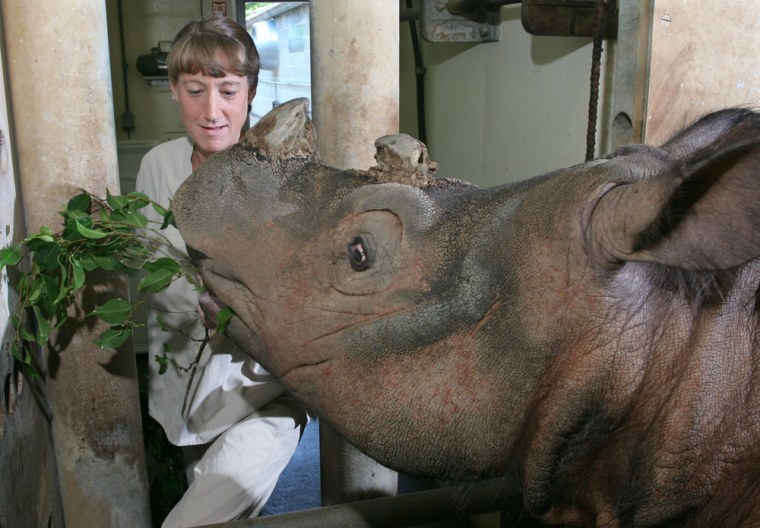Emi the Sumatran rhino is pregnant again, and that’s big news for conservationists from Ohio to Indonesia who are trying to save the critically endangered species.
It is believed that fewer than 300 Sumatran rhinos survive in Southeast Asia. Emi is the only one to give birth twice in captivity; her first delivery in 2001 was the first by a Sumatran rhino bred in captivity since the 19th century.
The Cincinnati Zoo & Botanical Garden announced Saturday that Emi is 173 days into a 16-month pregnancy, adding hope to efforts to save the species.
“We have a long, long way to go, but we do see some glimmers of hope,” said Terri Roth, who heads the zoo’s Center for Conservation and Research of Endangered Wildlife.
The center has relied on close monitoring of hormone levels, use of ultrasound, and years of patient observation and trial-and-error to learn how to successfully mate the Sumatran rhinos.
“The real significance is that it’s taken them a long time, but both through really great science and perseverance, they’ve got the technique down,” said John Lukas, president of the International Rhino Foundation, a conservation group based in Yulee, Fla. “The knowledge they’ve gained in Cincinnati is really critical.”
Contented mom
Oblivious to the historic nature of her condition, Emi contentedly chomped on handfuls of chopped bananas, apples, and sweet potatoes while undergoing an ultrasound. Scientists believe Emi will give birth to a male.
With big dark eyes, the snub-nosed, two-horned Sumatran rhinos, which stand 3 to 5 feet (1 to 1.5 meters) tall and weigh from 1,300 to 2,000 pounds (600 to 900 kilograms), can be “like big puppy dogs,” said Roth, who’s been working with Emi and the male Ipuh for 10 years now.
The breeding program grew out of an international recognition in the early 1980s that the Sumatran rhinos were disappearing at a rapid pace, their rain forest habitat being lost to logging and other development while poachers hunted them for horns that can be sold for tens of thousands of dollars for medicinal uses.
But little was known about caring for the Sumatran rhinos in captivity, let alone their mating habits and reproductive cycles. Of seven rhinos brought to U.S. zoos, only three survived by 1995. With breeding efforts in Malaysia and Indonesia also stalled, Emi, who came to the Los Angeles Zoo in 1991 from Indonesia, was relocated again to join Ipuh here.
Because they are solitary animals, rhinos placed in couples are more likely to fight each other than to mate. With so few remaining in the world, it can be unnerving to watch them attack each other with their long sharp teeth, Roth said.
“They’re a very different species,” said Roth, who eventually was able to understand Emi’s ovulation and reproductive cycle for timing their encounters.
Five miscarriages, then success
In 1997, Emi became pregnant and the word spread quickly among conservationists. But the first of five miscarriages soon followed.
“It was extremely frustrating those years when we kept experiencing the pregnancy losses, because you felt you were so close,” Roth said. “It was like a roller coaster.”
In the next pregnancy, Emi was given daily doses of the hormone progesterone, also used for human females with histories of miscarriages. Emi took hers soaked into slices of bread. On Sept. 13, 2001, she gave birth to a male calf, named Andalas.
But for the long-term goal of repopulating the breed, Roth didn’t want to rely on hormones, so Emi’s next pregnancy went normally without it and she delivered a female, named Suci, on July 30, 2004.
The zoo hopes to breed Emi, believed to be about 18 years old, at least four more times. Meanwhile, plans are in the works for her first offspring to go to Indonesia to get its breeding program moving. Andalas is at the Los Angeles Zoo, the only other U.S. zoo with a Sumatran rhino.
Challenging effort
Widodo Ramono, senior official at the Sumatran Rhino Sanctuary in Indonesia, where the three females haven’t reproduced with the male rhino there, said the captive breeding effort has been challenging.
“So far Cincinnati Zoo is the only project to be successful in breeding the Sumatran rhinos,” Ramono said. “Our hope is the bull rhino would be transferred as soon as possible.”
He said the Cincinnati success was “very good” for the breeding effort.
In Malaysia, Juanaidi Payne, technical adviser for Asian Rhino Elephant Action Strategy, said Cincinnati’s experience might provide clues to improving breeding success both in captivity and in the wild.
“It can only be concluded that either Cincinnati was blessed with extreme good fortune or, more likely, they provided superb care and solid science to their rhinos,” Payne said by e-mail.
He said increasing rhino protection efforts that battle poachers in their native habitat also is crucial to the conservation effort.
Associated Press Writer Zakki Hakim in Jakarta, Indonesia, contributed to this report.
